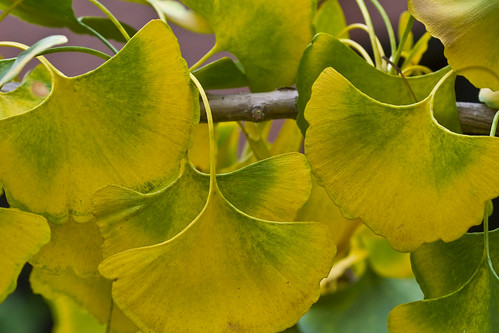These are leaves from a Ginkgo tree (Ginkgo biloba) on my campus. This plant is sometimes thought of as a living fossil since they belong to a very ancient group of plants, the phylum(divsion) Ginkgophytes. These plants go back to about 270 million years ago in the fossil record.
In fact this species was thought to be extinct. This site http://kwanten.home.xs4all.nl/fossils.htm
has lots of good Ginkgo fossil pictures.
Ginkgo makes a great landscape tree especially in urban areas. But one thing I don't like about this tree is that it doesn't seem to get visited by many insects-makes sense since it is not native to this part of the world.
Consider though that I am an entomologist so I am always a bit disappointed when a plant doesn't have at least some insect visitors. Something is missing.
Why Ginkgo doesn't seem to get visited by insects isn't clear to me. Maybe the insects that had co-evolved with Ginkgo were wiped out when the species almost went extinct, or maybe it really does have some adaptation that deters insects. There are a few insects recorded in the United States as visitors, but the list is very short even when compared with other introduced species. See for example this list of tree pests from New York City where Ginkgos are commonly used: http://www.grownyc.org/files/citylot/Diseases_and_Insects.pdf.
Curiously insect resistance or maybe insect non interest seems to be characteristic of a related group of plants-the cycads which are also considered to be living fossils, though I have not looked at this issue closely.

No comments:
Post a Comment